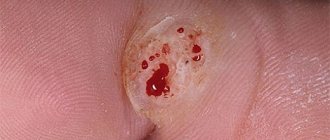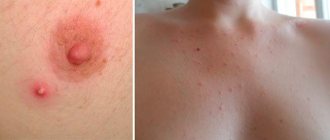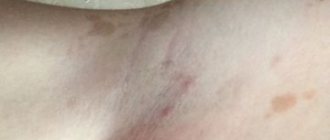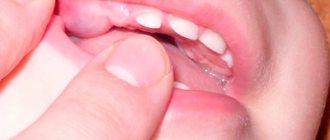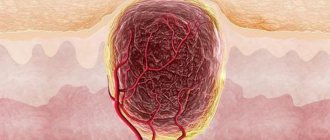A wart is a benign growth that appears on the skin or surface of mucous membranes. This cosmetic defect can even form in the mouth. Most often, warty growths are formed as a result of a person becoming infected with a viral infection and are contagious. Today we will talk about why warts appear on the tongue and how to treat this viral disease.
Wart in the mouth, a most unpleasant disease
All growths that appear in the mouth are of two types. The former appear under the influence of certain irritants, the latter occur rarely and represent a numerous nodular rash that spreads over the entire surface of the oral cavity.
Types of warts in the mouth
Warts in the mouth cause discomfort when talking and eating
Warts in the mouth of an adult or child are divided into several types. They differ from each other in their location in the oral cavity.
On the mucous membrane of the lip
Pathological growths often appear on the inside of the lip. They are distinguished by their special shape, reminiscent of a pacifier, and a light shade. When the virus is overactive, the tumors grow happily, creating entire colonies. These clusters begin to resemble cauliflower inflorescences. Such warts greatly complicate a person’s life. They interfere with eating and drinking normally and distort facial features (the lip protrudes).
On the gums
People who suffer from liver or kidney problems may develop a wart on the surface of the gum. Another reason for its appearance is frequent sore throats. Papillomas grow on the gum directly in the place that is most injured when chewing hard food or brushing teeth. If the immune system is weak, a wart will form on the wound.
Experts identify several types of warts that appear on the surface of the gums. They can be:
- Ordinary. Their appearance resembles small balls. Sometimes they appear flattened. Such papillomas suddenly appear and also suddenly disappear.
- Flat. They do not differ in color from the gums. It is this type of wart that most often occurs in the oral cavity as a result of damage to the mucous membrane.
- Condylomas. The wart is held on the gum by a thin stalk. It also has sharp tips. The structure of the benign growth is heterogeneous. If damaged, the wart begins to actively grow and hurt when it comes into contact with a hard surface.
Papillomas of the latter type are considered potentially dangerous to the health and life of the patient, as they can lead to the development of cancer.
On the tongue
The real problem is benign growths on the surface of the mucous membrane of the tongue. They form if a person does not adhere to basic rules for caring for oral hygiene. The infection can enter a vulnerable spot during oral sex with a carrier of a viral pathogen. It is activated by irregular nutrition, stress and decreased immunity.
Warty growths of this type are typically located on the tip of the tongue or on its lateral parts. The formation of a wart underneath cannot be ruled out. It looks like a flat papilloma or condyloma.
On the cheek
It is unpleasant to feel the papillomas that are located on the inside of the cheeks. Their presence in this part of the oral cavity is almost impossible to ignore. The growths on the cheek are easy to bite. This will cause severe pain in the affected area. Damaged tissues will begin to become inflamed and fester. Given these features, it is advisable for patients to immediately get rid of warts on the cheek as soon as they are discovered.
Papillomas on the gums
A wart on the gum can occur due to problems with the kidneys and liver. Frequent sore throats can also be a cause. If you use a brush that is too hard to brush your teeth, you can damage your gums and create a small wound. With weakened immunity, papilloma begins to grow at the site of the wound.
Neoplasms may differ from each other in type. Doctors distinguish the following types:
Simple warts look like small balls and can sometimes be flattened. Their distinguishing feature is that they can suddenly disappear on their own, just as they appeared.
Flat papillomas are always the same color as the oral mucosa. As a rule, they appear as a result of injury to the gums.
Condylomas are supported by a thin, barely noticeable stalk. They have sharp ends and a heterogeneous structure. If the condyloma is damaged, it will begin to grow quickly and hurt when pressed.
The danger of papillomas in the mouth is that neoplasms can lead to cancer.
Causes
Bad habits can activate the papilloma virus, resulting in warts
The oral cavity can be attacked by entire colonies of papillomas. People find them in their mouths in different places. A competent specialist can quickly identify this tumor in a person. And he himself may suspect the development of papilloma by comparing its appearance with a wart in a photo in a medical reference book.
A huge percentage of the population is infected with HPV. Therefore, many people may experience the formation of warts in their mouth. Their growth is caused by activation of the papillomavirus. The following factors contribute to this:
- decreased immunity;
- hormonal disorders;
- negative habits;
- frequent consumption of too hot food, which injures the oral mucosa;
- long-term use of hormonal and antibacterial drugs;
- neglect of oral care rules;
- practice of unprotected oral sex;
- emotional experiences and stress.
In the initial stages of development, a wart in the oral cavity is benign. But over time, under certain conditions, it can degenerate into a cancerous tumor.
How do papillomas appear?
The cause of all warts, including those localized in the oral cavity, is the human papillomavirus (HPV). The mouth is affected by strains of the disease numbered: 2, 6, 1, 30. Most often, people over the age of 30 suffer from papillomas in the mouth.
HPV cannot be killed by high or low temperatures, it is not taken by all available means of treatment, so it has captured almost 70% of the population of the entire globe. The virus can remain undetectable in the human body for a very long time. The only factor holding it back is strong immunity. As soon as the infected person’s defense mechanisms weaken, ideal conditions are created for the pathogen to become active. The main symptom of its awakening is the appearance of warts. The place of their localization can be the gums, lip, root and tip of the tongue, and cheek.
Other reasons for the activation of the virus may be the following:
- hormonal disbalance;
- obesity;
- advanced age;
- intestinal problems;
- chronic diseases;
- frequent injuries to the oral mucosa (in particular burns from eating too hot food);
- stress.
You can become infected with HPV:
- using other people's toothbrushes;
- not maintaining personal hygiene;
- eating from the same container with an infected person;
- through sexual intercourse;
- in utero.
There are cases when papillomas affect the oral mucosa of a child. This can be explained by the fact that the baby licked an infected object, or was infected from the mother during his stay in the womb. Warts of this type are very dangerous, as they can block the baby's airways, which can lead to death or disability.
Diagnostics
If you complain about the appearance of growths in the mouth, you should seek medical help from doctors of the following specialties:
- dermatologist;
- dentist;
- otolaryngologist.
The cost of a one-time visit to a specialist costs patients from 300 rubles. In public hospitals you can get a free doctor's consultation.
It is very important to determine the nature of the neoplasm and its benignity. To do this, it is not enough to simply examine the wart. Additionally, a PCR blood test is required. Its essence is to determine the strain of the virus and its danger to the patient. The study also provides information about the amount of the pathogen in the human body. The average cost of analysis is 700 rubles.
A biopsy may be required if cancer is suspected. The analysis in most clinics costs about 400 rubles.
Video on topic
A wart in the mouth may be an unpleasant occurrence. It is located on the tongue, palate, mucous membrane of the lip or gum. In almost all cases, benign growths in the oral cavity cause severe discomfort to a person. Such warts are very easily injured by food, cutlery or dentures. As a result, bleeding may begin. The possibility of infection in the wound cannot be ruled out. To avoid such problems, it is necessary to responsibly approach the issue of treating oral papillomas.
Treatment
Treatment involves two directions: removal of the wart and exposure to its root cause - the virus - with antiviral drugs and increased immunity
Treatment of a tumor on the palate or in another area of the oral cavity should be carried out under the supervision of a doctor. So far, medicine cannot offer patients a complete cure for papillomavirus. She can only eliminate existing growths on the body. For these purposes, drugs and surgical methods have been developed.
Traditional treatment
Recipes from traditional healers help remove the growth. However, their methods should be used wisely. Experts recommend that patients who intend to be treated with alternative means still combine them with medications in order to enhance the effect of the entire course. Otherwise, they are unlikely to be able to get rid of the tumor in the mouth.
When using folk remedies, precautions must be taken, as these remedies can damage the delicate mucous membrane of the mouth. Garlic works best against viral growths. In this case, garlic oil is required. They are recommended to treat the tumor up to 5 times a day. You can use propolis oil in the same way.
To prevent the appearance of new warts in the mouth, you should boost your immunity. Teas based on rose hips and echinacea help cope with this task.
Medications
If a person intends to get rid of the hated wart that has grown in his mouth, then he is prescribed complex therapy based on medications. Help to improve your condition:
- Antiviral agents.
- Retinoids.
- Interferon in the form of injections.
- Fluorouracil.
Additionally, doctors prescribe patients to take vitamin complexes that increase the body's defenses.
Surgical methods
Drug therapy does not always give a positive result. In this case, it is possible to cope with warts that have formed in the mouth using the following surgical techniques:
- Laser removal (from 450 rubles).
- Freezing with liquid nitrogen (from 230 rubles).
- Excision with a surgical scalpel (from 500 rubles).
- Radio wave therapy (from 500 rubles).
When treating warts in the oral cavity, it is prohibited to use electrocoagulation and other methods that involve cauterizing the growth. Only a doctor can know which treatment method to choose for a patient with papilloma in one or another part of the mouth. A person can only listen to the recommendations of an experienced specialist.
Growths on the tongue
Most often, papillomas on the tongue are formed when the rules for caring for the oral cavity are violated. The reason for their appearance is often intimate contact (oral sex) with an infected person. The type of human papillomavirus that leads to the appearance of papillomas on the tongue can be activated by poor, irregular nutrition and frequent stress.
Warts are usually located on the sides and tip of the tongue, but they can appear all over the surface and even underneath it. Rarely, but warts still form on the root of the tongue. According to their types, growths affecting the tongue are classified as condylomas and flat papillomas.
There are cases when this type of papillomas forms on the cheek. The internal side becomes the place of localization. Such warts can also be very annoying to their owner. Firstly, a person will constantly feel something in his mouth. A growth on the cheek can be accidentally bitten while eating, and this is very painful. Due to such an injury, the mucous membrane can become inflamed and even fester. You need to get rid of these warts urgently.
What to do
It is impossible to ignore the appearance of any formations on a child’s gums, therefore, when a growth appears, the baby should be immediately shown to the dentist. Only a qualified doctor can determine why a child has such a problem and how to properly treat it. Any folk remedies can only be used as a supplement to the treatment prescribed by the dentist.
If the doctor determines that the growth is represented by a teething tooth, he will only give recommendations on oral hygiene and elimination of the uncomfortable manifestations of the teething process. If the growth is caused by an infection, the dentist will immediately begin to treat the teeth to prevent it from spreading in the oral cavity.
When the roots of a baby tooth are deeply infected, in most cases the tooth itself is removed to prevent bacteria from penetrating the permanent tooth bud.
In a situation where the growth turns out to be a cyst that is bothering the child, it is most often removed. In addition, the cyst can become inflamed and infected, which is also a reason to remove it before such a formation becomes a source of infection in the mouth. Surgical treatment is also used when epulis is detected.
